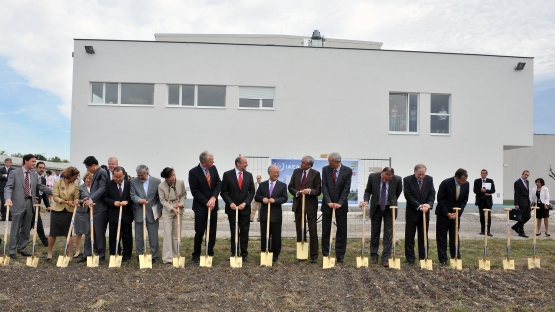On the site of the IAEA's new Nuclear Material Laboratory in Seibersdorf, Austria, the final half of the construction work on the building is now proceeding. The equipment installation and move from the Laboratory's current quarters will commence in about seven months. The new Laboratory is due to be completely equipped and in full operation by late 2014.
Since the IAEA's earliest days in the late 1950s, Agency scientists have analysed samples collected by IAEA safeguards inspectors. For decades since the adoption of the Nuclear Non-Proliferation Treaty (NPT), that analytical work was centred in the original Safeguards Analytical Laboratory. Inspection samples include uranium, plutonium and other materials taken from all points along the nuclear fuel cycle. Each is packaged to ensure the confidentiality of the sample's origin, such that the scientists are unaware of the country or facility from which the samples were obtained. The analysis focusses on the isotopic make-up of uranium or plutonium contained in the samples.
The analytical results provide a powerful tool for supporting conclusions as to the correctness and completeness of States' nuclear material declarations and help to inform the IAEA's evaluation of whether a State is complying with its safeguards obligations.
The new Nuclear Material Laboratory will be the largest component in the IAEA's multi-year capital project called Enhancing Capabilities of the Safeguards Analytical Services, or ECAS. The building will be adaptable to changing tasks and expandable as necessary. United Nations and IAEA (INFCIRC/225/Rev.5) standards for the security of personnel and nuclear material will be implemented.
In this time-elapse video, you will see the steel and concrete structure of the advanced laboratory and office building rise from a vacant field.
On 7 September 2011, with the Environmental Sample Laboratory's "Clean Lab Extension" already complete, Director General Yukiya Amano and Deputy Director General Herman Nackaerts unveiled the design model of the Nuclear Material Laboratory.
The construction team mobilized at the site in November 2011 and began excavation in mid-December. By February 2012, the pace of construction increased. Construction of the building's "shell and core" began with the basement, which will house the fissile material storage area behind thickened walls as well as a variety of workshop and maintenance areas.
In early spring, the walls of the ground floor laboratory and office spaces began to rise. The laboratory and office wings will comprise two floors. A top floor above the labs, begun in early summer 2012, houses the ventilation and other mechanical systems to ensure optimal conditions of air pressure and temperature for the functions of each space.
With the "shell and core" sufficiently advanced, the contractor began construction and equipment installations for the mechanical, electrical and plumbing systems. Some laboratory spaces will require the total replacement and filtering of a room's air content several times per hour. Hence, the systems include ventilation ducts large enough that an adult could walk inside them, but also room-specific controls to maintain distinct conditions of air pressure, temperature and humidity with minimal variance.
By mid-2013, a phased introduction of new and transferred instruments and equipment should begin a year-long transition of personnel and functions from the current, leased laboratory building into the IAEA's new Nuclear Material Laboratory. That transition should be complete, with the original laboratory vacated, by the end of 2014.


